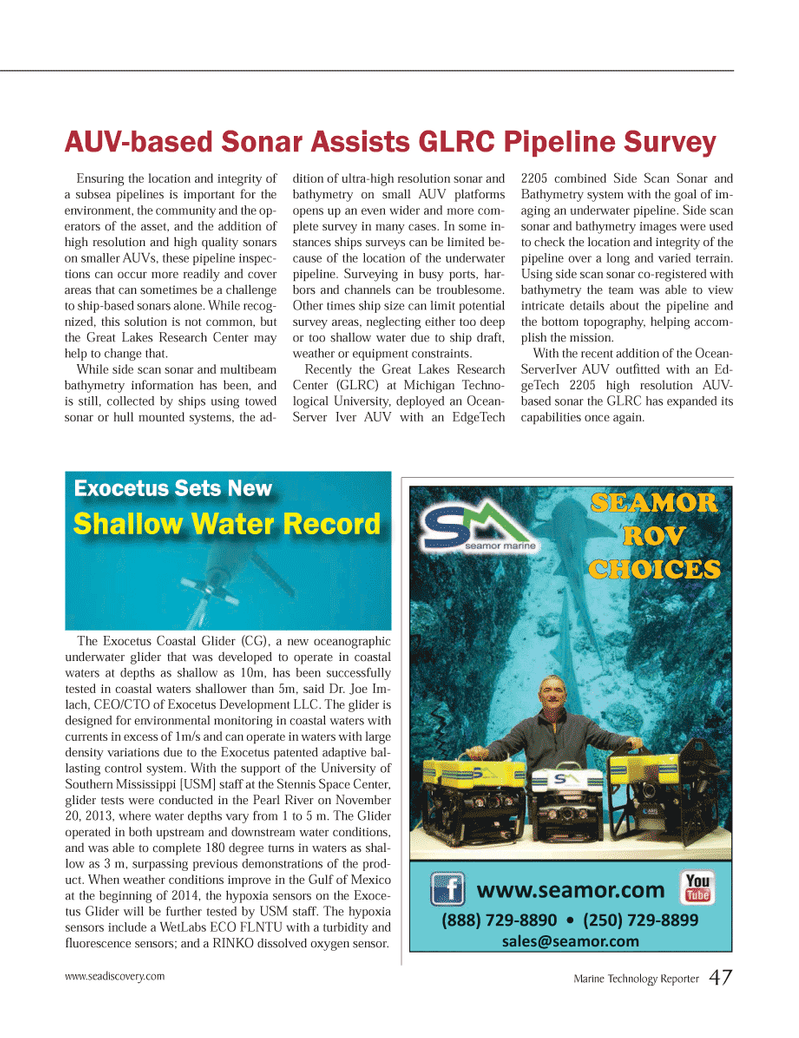
Page 47: of Marine Technology Magazine (November 2013)
Fresh Water Monitoring & Sensors
Read this page in Pdf, Flash or Html5 edition of November 2013 Marine Technology Magazine
SEAMORSEAMORROV ROV CHOICES CHOICES www.seamor.com [email protected] (888) 729-8890 ? (250) 729-8899Seamor MTR Nov Dec 13 .indd 111/27/2013 9:19:56 AMExocetus Sets New Exocetus Sets New Shallow Water Record Shallow Water Record Ensuring the location and integrity of a subsea pipelines is important for the environment, the community and the op- erators of the asset, and the addition of high resolution and high quality sonars on smaller AUVs, these pipeline inspec- tions can occur more readily and cover areas that can sometimes be a challenge to ship-based sonars alone. While recog- nized, this solution is not common, but the Great Lakes Research Center may help to change that. While side scan sonar and multibeam bathymetry information has been, and is still, collected by ships using towed sonar or hull mounted systems, the ad-dition of ultra-high resolution sonar and bathymetry on small AUV platforms opens up an even wider and more com- plete survey in many cases. In some in- stances ships surveys can be limited be- cause of the location of the underwater pipeline. Surveying in busy ports, har- bors and channels can be troublesome. Other times ship size can limit potential survey areas, neglecting either too deep or too shallow water due to ship draft, weather or equipment constraints. Recently the Great Lakes Research Center (GLRC) at Michigan Techno- logical University, deployed an Ocean- Server Iver AUV with an EdgeTech 2205 combined Side Scan Sonar and Bathymetry system with the goal of im-aging an underwater pipeline. Side scan sonar and bathymetry images were used to check the location and integrity of the pipeline over a long and varied terrain. Using side scan sonar co-registered with bathymetry the team was able to view intricate details about the pipeline and the bottom topography, helping accom- plish the mission. With the recent addition of the Ocean- ServerIver AUV outÞ tted with an Ed- geTech 2205 high resolution AUV- based sonar the GLRC has expanded its capabilities once again. The Exocetus Coastal Glider (CG), a new oceanographic underwater glider that was developed to operate in coastal waters at depths as shallow as 10m, has been successfully tested in coastal waters shallower than 5m, said Dr. Joe Im- lach, CEO/CTO of Exocetus Development LLC. The glider is designed for environmental monitoring in coastal waters with currents in excess of 1m/s and can operate in waters with large density variations due to the Exocetus patented adaptive bal- lasting control system. With the support of the University of Southern Mississippi [USM] staff at the Stennis Space Center, glider tests were conducted in the Pearl River on November 20, 2013, where water depths vary from 1 to 5 m. The Glider operated in both upstream and downstream water conditions, and was able to complete 180 degree turns in waters as shal- low as 3 m, surpassing previous demonstrations of the prod- uct. When weather conditions improve in the Gulf of Mexico at the beginning of 2014, the hypoxia sensors on the Exoce- tus Glider will be further tested by USM staff. The hypoxia sensors include a WetLabs ECO FLNTU with a turbidity and ß uorescence sensors; and a RINKO dissolved oxygen sensor. AUV-based Sonar Assists GLRC Pipeline Survey www.seadiscovery.com Marine Technology Reporter 47MTR #9 (34-49).indd 47MTR #9 (34-49).indd 4712/13/2013 9:36:44 AM12/13/2013 9:36:44 AM

 46
46

 48
48
